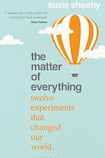
Our understanding of the universe, the world we inhabit and the nature of reality have been shaped by the information mined from thousands of scientific experiments performed across our history.
Suzie Sheehy, a science communicator and particle physicist at the universities of Oxford and Melbourne, outlines the personalities and science behind 12 experiments she believes changed the world.
Those of us who struggled with physics at school may flinch at revisiting the subject by reading about cathode tube ray experiments or the investigations of the photoelectric effect that are expounded on here at length. Yet, as is the case for experimental physicists, rich rewards are awaiting those possessed with bravery, patience and persistence.
Many of us may have little or no interest in how subatomic quarks, leptons and neutrinos were discovered. But the passion the author brings to her 12 tales, her ability to communicate difficult scientific concepts in clear terms and her explanations of why it matters to all of us draw the reader in.
The author also makes a formidable case for the need for taxpayers and governments to support curiosity-driven research, even when it seems to have little immediate relevance to the real world. The case in point, she argues, is particle physics, an obscure field where scientists search for particles smaller than an atom.
Finding subatomic particles invisible to the human eye or to existing microscopes was a huge scientific challenge that required money, scientific brain power and thousands of experts working together.
Throughout the 20th century protons and neutrons were found, then even smaller particles like quarks and neutrinos.
The knowledge gained from such Big Science or even Mega Science ventures, led to MRI scanners to diagnose disease, radiotherapy to treat disease, as well as the web and cloud computing.
The author begins with the discovery of the electron by JJ Thompson in 1897 and finishes with the Large Hadron Collider, which was fired up in 2009, and the finding of the Higgs Boson particle.
She points out that while much about the subatomic world has been revealed, this is a scientific voyage that is just beginning. Scientists do not know what 95 per cent of the universe is made up of, and they are sure more particles exist that have not been discovered.
This next stage, she says, will involve even bigger projects leading to exciting new knowledge and technologies that will improve our lives.















